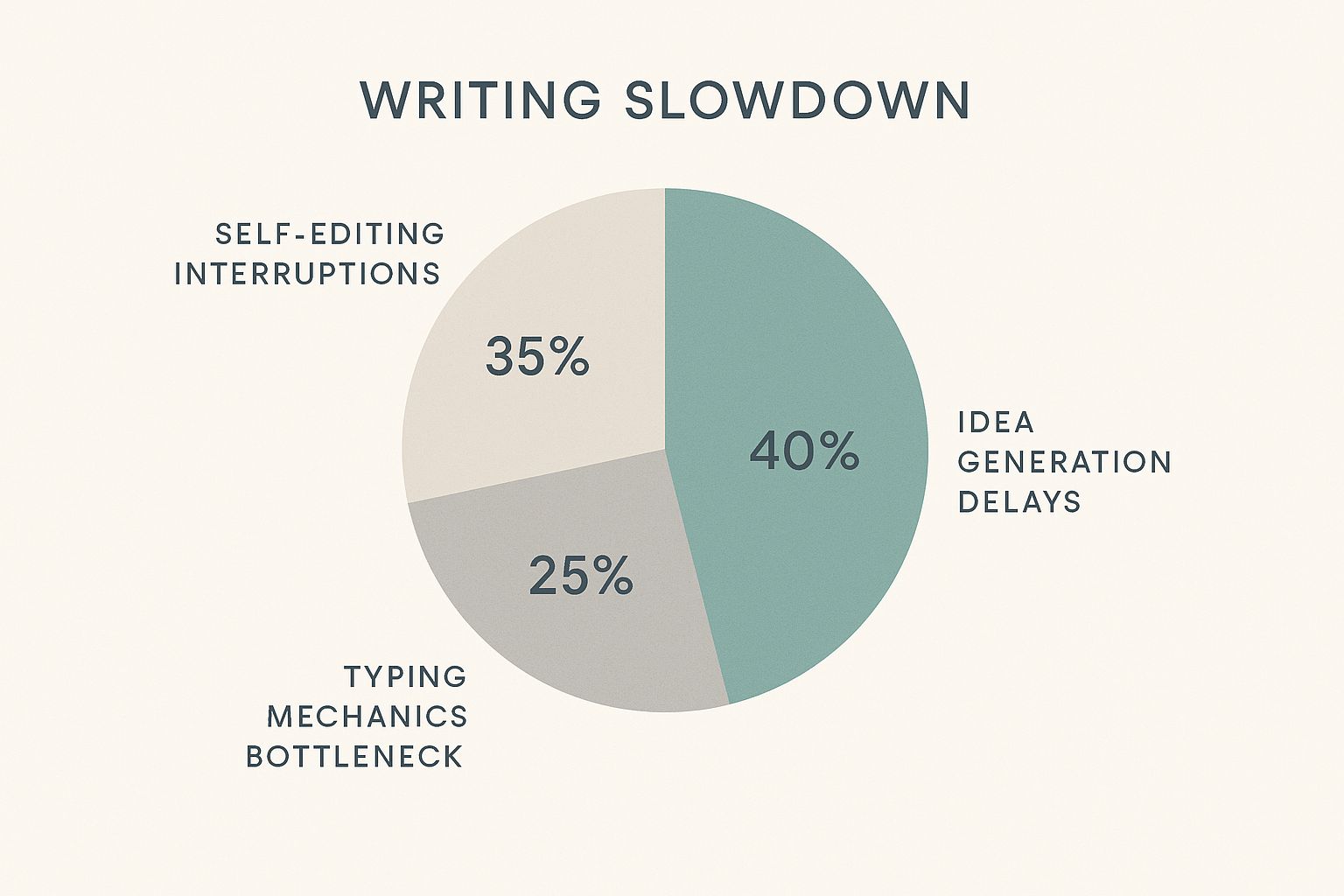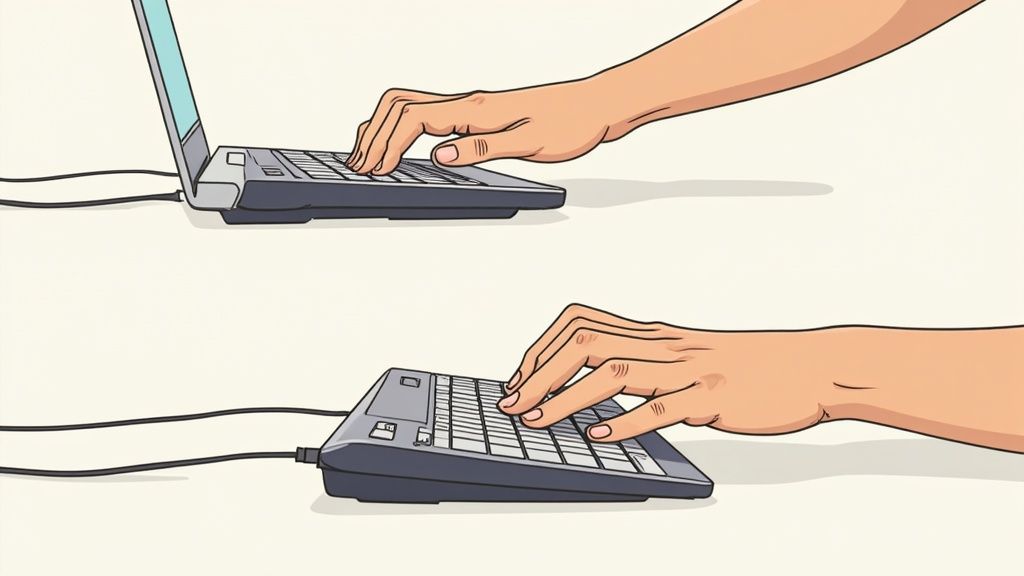How to Improve Writing Speed and Write Faster
Discover how to improve writing speed with our friendly guide. Learn practical techniques to stop editing as you go and write faster than ever before.
Oct 13, 2025

If you want to write faster, you first have to figure out what's slowing you down in the first place. It’s rarely about how fast your fingers can fly across the keyboard. The real culprits are usually the constant urge to self-edit, the mental gymnastics of pulling ideas out of thin air, and the endless digital distractions pulling you away from the page.
Nailing down your biggest hurdle—whether it's mechanical, mental, or environmental—is the absolute first step toward speeding up your writing.
What's Really Putting the Brakes on Your Writing?
Ever have that feeling where your thoughts are miles ahead, but your fingers feel like they’re stuck in concrete? It’s a common frustration. Before we dive into specific tactics, it's worth understanding the roadblocks that are actually getting in your way. Getting faster isn't just about typing; it's about streamlining your entire creative process.
Most writers bump up against a few common obstacles that drain their productivity. They aren't always obvious, but once you spot them, you can start using the right strategies to get past them.
The Three Big Bottlenecks
So, what are these speed bumps? They almost always fall into one of three buckets:
Mental Friction: This is all about the cognitive heavy lifting—coming up with ideas, organizing your thoughts, and wrestling with words. That classic "staring at a blank page" moment? That's mental friction at its finest. A great way to get past this is to separate your brainstorming from your drafting, a technique we cover in our guide on how to overcome writer's block.
The Self-Editing Trap: I see this all the time. Writers try to edit every sentence as they write it, which is a massive momentum killer. When you’re constantly flipping the switch between your creative brain and your critical brain, you can't get into a flow. That’s how a quick 30-minute draft turns into a two-hour slog.
Mechanical and Environmental Hurdles: This category covers everything from slow typing to the never-ending stream of notifications. Online distractions are a huge one; learning how to block distracting websites can be a game-changer for reclaiming your focus.
This infographic really puts the common writing slowdowns into perspective.

The numbers don't lie. A whopping 75% of slowdowns are cognitive—they come from that internal battle of generating ideas and trying to perfect them on the fly. Only a quarter of the problem is about actual typing speed.
Even the simple physical act of writing can make a difference. Neuroscience shows that handwriting fires up more areas of the brain involved in motor skills, which can actually speed up how you process thoughts and remember words. It’s a fascinating look at how deeply connected our physical actions and mental processes really are.
Build a Solid Foundation with Keyboard Mastery

Before we get into fancy workflows or AI tools, let's go back to basics. The single most important tool you have is your keyboard. I like to think of typing ability as the engine of my writing—even a small tune-up can have a massive impact on how much I get done.
Boosting your words per minute (WPM) is a real, measurable way to shorten the frustrating gap between an idea in your head and the words appearing on the screen. Too many writers assume their typing speed is just "how it is," but I can tell you from experience that with a little focused practice, you can make huge improvements. It's not just about speed, either. It’s about building the accuracy and confidence to let your fingers fly without interrupting your creative flow.
The average typing speed hovers around 52 WPM, which is a number that hasn't budged much since the professional typists of the 1970s. The real pros, however, use advanced techniques like engaging five or more fingers and "rollover"—a method of hitting multiple keys in rapid, overlapping succession. Getting comfortable with your keyboard is truly one of the fastest paths to becoming a faster writer. You can dig into some fascinating typing speed statistics to see what separates the speedsters from everyone else.
To give you a clearer picture of where you stand and what to aim for, here’s a quick breakdown of different typing speeds.
Typing Speed Benchmarks and What They Mean
A quick comparison of different typing speeds to help you set realistic goals for improvement.
WPM Range | Skill Level | Practical Impact |
|---|---|---|
Below 40 WPM | Beginner / Casual | Writing can feel slow and laborious; you might "hunt and peck" for keys. |
40-70 WPM | Average / Competent | You can keep up with your thoughts for the most part but have room to improve. |
70-100 WPM | Proficient / Fast | Typing feels effortless. You can draft content quickly without the keyboard getting in the way. |
100+ WPM | Expert / Elite | You're in the top percentile. The keyboard is a seamless extension of your thoughts. |
No matter where you fall on this chart, a little deliberate practice can easily bump you into the next tier.
Master Ergonomics and Hand Positioning
How you sit and where you place your hands is the foundation for fast, comfortable typing. I learned this the hard way. Bad habits don't just slow you down; they lead to wrist strain, shoulder pain, and burnout. The goal is to create a relaxed, neutral setup that lets you move freely.
Start by getting your chair and desk height right. Your elbows should be at a relaxed 90-degree angle, with your wrists straight—not angled up or down. Let your fingers rest naturally on the home row keys (that’s ASDF for your left hand and JKL; for your right). This is your starting block for every word, and sticking to it cuts down on a ton of wasted hand movement.
A few things to keep in mind:
Keep Wrists Straight: Try to let your wrists float just above the keyboard instead of planting them on the desk. This is a game-changer for avoiding strain.
Sit Upright: Slouching is an energy killer. Good posture keeps you focused and prevents that nagging neck and back pain.
Relax Your Shoulders: Tension is the enemy of speed. I often have to remind myself to unclench my shoulders before and during a long writing session.
Train for Accuracy and Speed
Once your setup is dialed in, it's time for the real work. The single biggest leap forward comes from breaking the habit of looking at your keyboard. Keep your eyes on the screen. This is crucial because it lets you see and fix typos in real time without breaking your rhythm.
The most impactful change you can make is committing to touch typing—using muscle memory to find keys without looking. It feels slow and clumsy at first, but pushing through that initial discomfort is where the real progress happens.
Here are a few practical exercises I’ve used to build this skill:
Home Row Drills: Just type "asdf jkl;" over and over without looking. It feels silly, but it drills that foundational position into your muscle memory.
Common Word Practice: Focus on typing common words that make your fingers move around the keyboard. This helps you get used to the letter combinations you’ll use most often.
Use Typing Tutors: Don’t just practice randomly. Websites like Keybr or Monkeytype are fantastic because they use data to find your weak spots and give you targeted drills to fix them.
Think about it this way: a small jump from 50 to 70 WPM means you can draft a 1,000-word article in about 14 minutes instead of 20. That time really adds up, giving you more space for the important stuff like editing, brainstorming, or just stepping away for a much-needed break.
Find Your Flow with Speech-to-Text Writing

What if you could capture your thoughts at the exact speed they pop into your head, without your fingers getting in the way? That’s the real promise of speech-to-text writing. It's a game-changer, not just for firing off a quick text, but for drafting entire articles, book chapters, and reports just by talking.
When you separate the creative act of thinking from the physical mechanics of typing, you often find a more natural, fluid stream of ideas. The point is to get that messy first draft onto the screen in a fraction of the usual time. This frees you up for what really matters: editing and polishing your work later.
Getting Started with Dictation
Let's be honest—the first hurdle is just getting over the awkwardness of talking to your computer. My advice? Just power through it. The first couple of times might feel a little silly, but once you find your rhythm, the speed you gain is incredible.
To make things easier on yourself, find a quiet spot where you won’t be disturbed. Also, using a decent microphone makes a world of difference for accuracy. Even the mic on your headphones is a huge step up from the one built into your laptop.
The real magic of dictation happens when you stop thinking about "writing" and start thinking about "telling." Just pretend you're explaining your topic to a friend. This simple mental shift helps your words flow so much more naturally.
Practical Tips for a Smooth Workflow
To really get the most out of dictation, you need to do a bit more than just talk at your screen. Learning a few basic commands for punctuation and formatting is key, and it will save you a massive headache during cleanup.
Here are a few things that have personally helped me speed up my writing with dictation:
Speak Your Punctuation: Get in the habit of saying "period," "comma," and "new paragraph" out loud. It feels weird at first, but it quickly becomes second nature and helps create a structured document from the get-go.
Enunciate Clearly: You don't have to talk like a robot, but try to speak at a steady, clear pace. Mumbling is the fastest way to get a screen full of transcription errors and a major dose of frustration.
Dictate in Chunks: No one says you have to dictate an entire article in one sitting. I often use it just to brainstorm an outline, draft a tricky section, or get a few paragraphs down when I'm feeling stuck at the keyboard.
Weaving Dictation into Your Daily Routine
The real power move is finding ways to fit dictation into your existing workflow. For instance, I’ll often dictate the outline for a blog post into my phone while I’m on my morning walk. It’s a fantastic way to capture ideas when I'm away from my desk and my mind is fresh.
If you’re brainstorming a complicated report, you can talk through the main points hands-free, recording your train of thought as it happens. This gets the core ideas down fast, leaving you with a solid foundation to build on later. If you're looking for the right tool, you can explore some of the best dictation software for writers to see what fits your style.
When you start treating speech-to-text as your go-to tool for that initial "brain dump" phase, you can slash your drafting time. It helps you sidestep that inner critic that slows us all down at the keyboard, letting you focus purely on getting your ideas out into the world.
Separate Your Drafting and Editing Modes

If there's one habit that absolutely demolishes writing speed, it’s trying to edit as you draft. I’ve seen it time and again. It’s like flooring the gas and hitting the brake at the same time—you just lurch forward, stop, and get nowhere.
Trying to use your creative brain (the idea generator) and your critical brain (the perfectionist) simultaneously is a recipe for frustration. This constant mental gear-shifting is exhausting, and it’s the number one killer of writing flow. The real secret? Treat them as two completely separate jobs.
Embrace the Messy First Draft
Your first draft has one purpose and one purpose only: to exist. It’s not supposed to be pretty. It just needs to get done.
You have to give yourself permission to write badly. Seriously. Let typos happen. Let sentences wander. The goal is just to get the ideas out of your head and onto the page, pure and simple.
One of the best ways I’ve found to force this separation is with timed writing sprints. The Pomodoro Technique works beautifully for this. Set a timer for 25 minutes and just write. Don't look back, don't second-guess yourself, and for the love of all that is holy, don't touch the backspace key unless you’ve typed complete gibberish.
The objective isn't perfection; it's momentum. During a writing sprint, your only task is to get words onto the page. You're pouring the foundation, not decorating the house. The polishing comes later, once the concrete has set.
This disciplined approach trains your inner editor to sit down and be quiet, which is absolutely essential for building speed. When that timer rings, take a quick break. Then do it again. You’ll be shocked by how much you can crank out when you stop judging every word the moment it appears.
Use Placeholders to Maintain Flow
So, what do you do when you hit a spot where you need a specific stat, a person's name, or a link you can't remember off the top of your head? Stopping to Google it is a surefire way to kill your momentum.
Instead of letting a research rabbit hole derail your draft, use a placeholder.
A trick I’ve used for years is the "TK" marker. "TK" is a letter combo that almost never appears in English, which makes it super easy to search for later. When you hit a detail you need to fill in, just type something like:
"According to a recent study [TK STATISTIC HERE], employee productivity..."
"As Jane Doe mentioned in her book [TK BOOK TITLE]..."
"For more details, you can explore our guide on [TK LINK]."
This simple move lets you flag the missing piece without breaking your stride. After the draft is finished, you can just do a quick search for "TK" to find all the spots you need to circle back to and fill in. This is a core part of an efficient document workflow automation process, keeping your creative and logistical tasks from tripping over each other.
By splitting your process into two distinct modes—draft first, edit second—you get rid of the friction and let yourself write faster and more freely than ever before.
How to Build a Practice Routine That Sticks
Let's be real: lasting improvement doesn't come from a magic bullet or a weekend cram session. If you really want to get faster at writing, you need a smart, sustainable training plan that builds muscle memory and sharpens your mind. The whole point is to make speed an automatic habit, not something you have to force.
A solid routine isn't just about mashing keys faster. It’s a mix of different exercises. You might be surprised to learn that even slower, old-school activities like handwriting can build powerful connections in your brain that boost your overall writing skills. Research has shown a direct link between how well we move our hands and how fast we can write. One study even found that handwriting speed shot up from 25 to 72 letters per minute between 3rd and 8th grade, all thanks to consistent practice. You can dive deeper into how motor skills influence writing progression if you're curious.
Assemble Your Personal Toolkit
Getting faster means targeting your specific weak spots, so you need a mix of tools and techniques that fit you. This isn't a one-size-fits-all deal. Think of it as building your own personal writing gym.
A dedicated typing tutor is a fantastic place to start. Free tools like Keybr or Monkeytype are brilliant for pushing your speed and accuracy. They use smart algorithms to figure out which letters trip you up and then feed you drills to fix them, making every minute of practice count.
Of course, pure speed is only half the battle. A truly effective routine also hones your core writing abilities. For a deeper dive, check out these proven tips to enhance your overall writing craft.
Stop Typing the Same Things Over and Over
One of the biggest, sneakiest time-wasters in writing is repetition. How many times a day do you type your email address, a standard sign-off, or a clunky industry term? This is where text expanders are a game-changer.
A text expander is a slick little utility that lets you create custom shortcuts for words, phrases, or even whole paragraphs you use all the time. For instance, I use ";eml" and it instantly pops in my full email address. It saves me just a few seconds, but I probably do it a dozen times a day.
It sounds small, but trust me, those seconds add up and keep you in the flow. Here’s how you could put one to work:
Common Phrases: Set up a shortcut like ";thx" to expand to "Thank you for your time and consideration."
Complex Terms: Use ";murmur" to instantly type out "MurmurType speech-to-text application."
Canned Responses: Create shortcuts for entire email replies you find yourself sending over and over.
By getting these little repetitive tasks off your plate, you save a surprising amount of mental energy and keep your momentum going. The key is building a simple, consistent routine. A ten-minute typing drill here, setting up a new text expansion there—it all compounds over time until faster, more fluid writing just becomes second nature.
Got Questions About Writing Faster? Let's Talk.
As you start weaving these techniques into your daily routine, you're bound to have some questions. It’s completely normal. Let’s go through a few of the most common ones I hear from writers who are just starting down this path.
Getting these out of the way can help you sidestep a few common roadblocks and feel a lot more confident as you build your new, faster workflow.
So, How Long Does This Actually Take?
This is always the first question, and the most honest answer is: it really depends on where you're starting from and how much time you put in. The good news is, if you're consistent, you'll likely see results faster than you think.
When it comes to pure typing skills, just 20-30 minutes of focused practice each day can make a real difference. We're talking noticeable gains in your words-per-minute (WPM) in as little as two to four weeks. The trick is deliberate practice—not just hammering out emails, but running through actual typing drills designed to improve speed and accuracy.
Speech-to-text is a different beast. It can feel a little strange and clunky for the first week or so. But once you get over that initial hump and it clicks? You could literally double your drafting speed overnight. It's all about pushing through that initial awkward phase.
Will Dictating Make My Writing Sound... Weird?
That’s a fair question, and one I get all the time. When you first start using speech-to-text, your writing will probably sound a lot more conversational than you're used to. That’s because you’re speaking, not typing.
The magic isn't in trying to speak like a perfect, polished writer from the get-go. Instead, you learn to trust the editing process.
Think of dictation as getting your raw clay onto the table. It’s messy and shapeless, and it's not supposed to be the final sculpture. The goal is to get the raw material down fast, and then you can switch hats and become the artist who refines and polishes it.
The whole point of dictating is to crush that first draft quickly. The polish always comes later.
Can I Get Faster Without Being a Touch-Typing Whiz?
You absolutely can. Things like creating a rock-solid outline, splitting your writing and editing sessions, and, of course, using speech-to-text will all boost your output, no matter your current WPM.
But I have to be honest: learning to touch type is the single biggest mechanical upgrade you can give yourself. "Hunt and peck" typing puts a hard, low ceiling on how fast you can ever hope to be.
Investing even a little time to learn proper hand placement is a game-changer. It’s a foundational skill that pays you back for the rest of your career, turning the keyboard from a clumsy barrier into a natural extension of your brain.